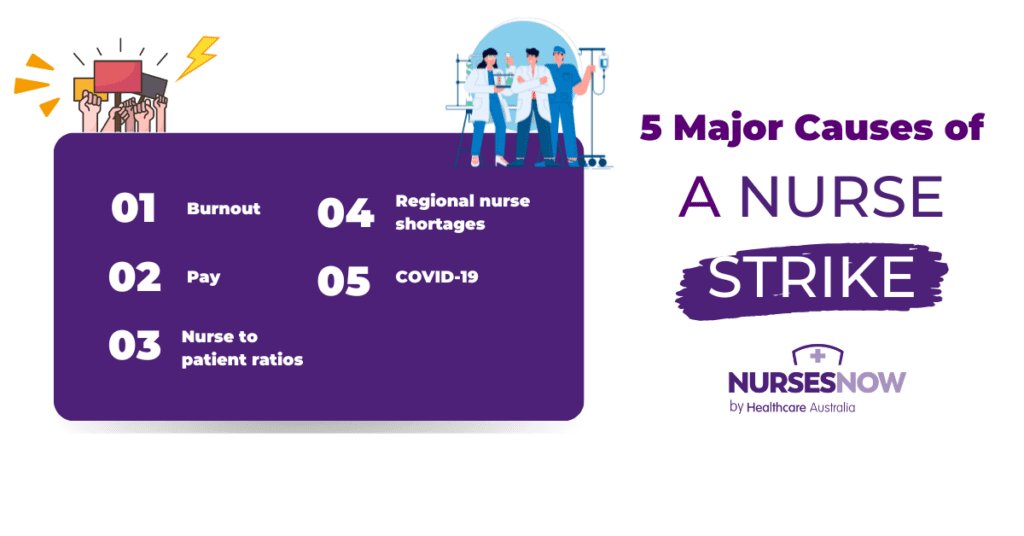Two major nurse strikes, involving thousands of nurses and midwives, were held on February 15 and March 31 this year. The protests highlighted a series of unresolved issues that nurses say have pushed them to breaking point.
If you are a nurse and are wondering how the nurse strike affects you, you need to understand what causes a nurse strike.
What is the Purpose of a Nurse Strike?
A strike is a protest where members of an industry all refuse to work for an agreed amount of time. They usually occur when members of an industry feel that their needs or demands are not being met. By striking, they can force the government or regulatory bodies to act on their demands.
Nurse strikes usually don’t last longer than a day. Nurse strikes on behalf of themselves and their patients, so they want to limit the disruption to the patients as much as possible. The purpose of the nurse strikes is to create action and awareness, not to stop doing their jobs.
There are many pain points that have led to the recent nurse strikes in Australia. Learn what they are and why they are such contentious subjects.
5 Major Causes of a Nurse Strike

1. Burnout
The biggest issue faced by the nursing industry is high levels of burnout. In Australia, over 58% of nurses report burnout, and 71% say they have more work than they can handle.
Learn more about burnout, including how to spot it and how to fix it.
These are concerning statistics that are symptomatic of more concerning underlying issues in the healthcare industry.
2. Pay
Securing a pay rise is one of the most common reasons for a nurse strike to be held. The higher the workload, the higher most people expect their wages to be. This is particularly true for nurses, who have to deal with:
- Long working days and hours
- Necessary overtime
- Unsocial working hours
- Potentially violent or infectious patients
- Losing patients
- Speaking with the families of terminal or deceased patients
While nurses are proud of the care they provide, and get satisfaction from it, they also want to be fairly compensated for their work.
The NSW government limits public sector pay growth to 2.5% annually, however, the union argues that this is unreasonable as inflation is increasing at a rate of 3.5%.
In the recent nurse strikes, the nurses union has asked for a 5.5% pay rise. This figure has been proposed to account for inflation, and the pronounced effect that COVID has had on nurses over the past three years.
Receiving a lower wage than you feel you deserve can affect your ability to do your job. Feeling unappreciated can lead to cynicism and low morale, and financial stress can add pressure to an already stressful role.
Anything that hampers a nurse’s performance is bad news for patients. Therefore, striking about wages is still, albeit indirectly, a call to improve healthcare for patients as well.
3. Nurse to patient ratios
A nurse-to-patient ratio is the amount of nurses working compared to the amount of patients they are responsible for. A lower nurse-to-patient ratio is one where there are a higher number of nurses providing care.
Lower nurse-to-patient ratios have been proven to provide better patient care. A 2021 study that observed the health outcomes of patients in QLD hospitals with minimum ratio requirements found that:
- Patient mortality rates were much lower in hospitals with minimum ratios than in those without
- Readmission rates were lower in hospitals with minimum ratios than than in those without
- Length of stay (LOS) rates were lower in hospitals with minimum ratios than than in those without
- Costs were lower in hospitals with minimum ratios because the reduction of readmissions and LOS’s actually reduced the number of nurses needed to maintain the ratios
This data clearly indicates that lower ratios are better for patient outcomes – and for the nurses themselves. With a manageable number of patients, nurses can work safely and effectively. Providing quality care improves job satisfaction, rather than causing burnout from feeling ineffective.
Ratios have been a major part of the recent nurse strikes. New minimum ratios of one-to-four nurses in hospital wards, and one-to-three midwives, is the expectation communicated by the protestors.
4. Regional nurse shortages
Staffing shortages aren’t just a factor in nurse-to-patient ratios. Regional areas often have short-staffed healthcare services. This is due to their smaller populations and vast distances from Australia’s major cities. With 28% of Australians living in rural areas, It’s no surprise that their healthcare access is a contentious issue.
Learn more statistics about regional Australian healthcare.
COVID-19 has exacerbated this shortage because nurses in regional areas have been inundated with patients, or required to help with other roles such as vaccinations or PCR testing. Many regional towns have held full day strikes, with specific messaging about improving nurse numbers in rural areas.
5. COVID-19
While burnout may be a symptom of many of these talking points, COVID has been more of a causal factor. Every system has flaws, and the Australian healthcare system is no different. The problem with something like a pandemic is that it turns small cracks into huge fissures that can’t be ignored.
COVID-19 put nurses on the frontlines of the pandemic without any substantial wage increase, it strained nurse-to-patient ratios with influxes of patients, and it has overwhelmed fledgling nurse numbers in regional hospitals.
Nurses are upset, and feel like their efforts have been taken for granted. Their passion for their work has also been stained by not being able to give the one-on-one care that patients require. Now that the pandemic has eased, many nurses are finally taking stock of their experience over the past three years – and they aren’t happy.
As an agency nurse, you can help
Now that you understand the pressures faced by the nursing industry, you might be wondering how you can help. Have you considered joining a nursing agency?
Nurses Now specialise in providing their team with flexible working arrangements. You can work in different fields and locations, depending on your qualifications and your preferences.
With nurse shortages across various healthcare departments, by becoming an agency nurse you can be sure that you are working where you are needed most.
If you would like to find out more about Nurses Now, click here. If you are ready to work where you are needed and on your terms, join now.



